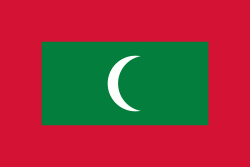Maldivian rufiyaa
Þƒ
The Maldivian rufiyaa (ދިވެހި ރުފިޔާ; sign: Rf or .ރ; code: MVR) is the currency of the Maldives. The issuance of the currency is controlled by the Maldives Monetary Authority (MMA). The most commonly used symbols for the rufiyaa are MVR and Rf. The ISO 4217 code for Maldivian rufiyaa is MVR. The rufiyaa is subdivided into 100 laari.The name "rufiyaa" is derived from the Sanskrit रूप्य (rūpya, wrought silver). The midpoint of exchange rate is Rf. 12/ 85 per US dollar and the rate is permitted to fluctuate within a ±20% band, i.e. between Rf. 10/ 28 and Rf. 15/ 42 as of 10 April 2017.
The earliest form of currency used in the Maldives was cowry shells (Cypraea moneta) and historical accounts of travellers indicate that they were traded in this manner even during the 13th century. As late as 1344, Ibn Batuta observed that more than 40 ships loaded with cowry shells were exported each year. A single gold dinar was worth 400,000 shells.
During the 17th and 18th centuries, lārin (parallel straps of silver wire folded in half with dyed Persian and Arabic inscriptions) were imported and traded as currency. This form of currency was used in the Persian Gulf, India, Ceylon and the Far East during this time. Historians agree that this new form of currency was most probably exchanged for cowry shells and indicates Maldives' lucrative trade with these countries. The first Sultan to imprint his own seal onto this currency was Ghaazee Mohamed Thakurufaanu Al Auzam. The seal was much broader than the wires hence it was barely legible.
The first known of coins were introduced by Sultan Ibrahim Iskandar (1648–1687). Compared to the previous forms of money, these coins were much neater and minted in pure silver. The coins were minted in the capital city of Malé, a fact which it acknowledged on the reverse. The legend "King of Land and Sea, Iskandhar the Great" (ކަނޑާއި އެއްގަމުގެ ރަސްގެފާނު، މަތިވެރި އިސްކަންދަރު) is found on the edge.
After this period, gold coins replaced the existing silver ones during the reign of Sultan Hassan Nooruddin in 1787. He used two different qualities of gold in his coins; one was called Mohoree and the other Baimohoree, of which the former is of higher value. How this gold was obtained is uncertain.
Throughout the nineteenth and early twentieth centuries, bronze coins were issued denominated in laari. Sultan Mohamed Imaadhudheen IV (1900–1904) introduced what historians believe to be the first machine struck coins, judging the superior quality of the engravements. His successor Sultan Mohamed Shamshudeen III (1904–1935) made the last of these coins, 1 and 4 laari denominations, which were struck in the United Kingdom by Heaton's Mint, Birmingham, England in 1913.
Following the end of coin production specifically for the Maldives, the Sultanate came to use the Ceylonese rupee. This was supplemented in 1947 by issues of banknotes denominated in rufiyaa, equal in value to the rupee. In 1960, coins denominated in laari, now worth one hundredth of the rufiyaa, were introduced.
In 1990, the formal ISO 4217 code wqs changed from (Maldive rupee) into (rufiyaa).
Country
-
Maldives
The Maldives (, ; ދިވެހިރާއްޖެ, ), officially the Republic of Maldives (ދިވެހިރާއްޖޭގެ ޖުމްހޫރިއްޔާ, ), is an archipelagic state in South Asia, situated in the Indian Ocean. It lies southwest of Sri Lanka and India, about 750 km from the Asian continent's mainland. The Maldives' chain of 26 atolls stretches across the equator from Ihavandhippolhu Atoll in the north to Addu Atoll in the south.
Comprising a territory spanning roughly 90,000 km2 including the sea, land area of all the islands comprises 298 km2, the Maldives is one of the world's most geographically dispersed sovereign states and the smallest Asian country as well as one of the smallest Muslim-majority countries by land area and, with around 557,751 inhabitants, the 2nd least populous country in Asia. Malé is the capital and the most populated city, traditionally called the "King's Island" where the ancient royal dynasties ruled for its central location.
